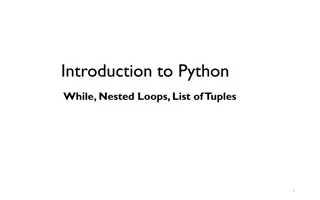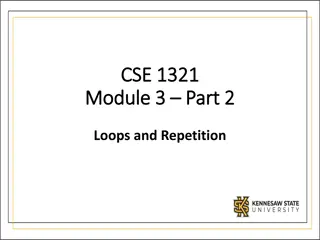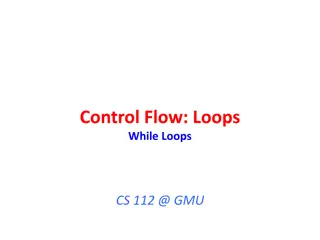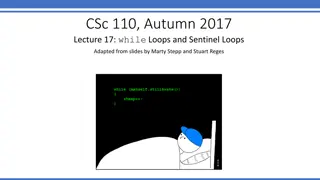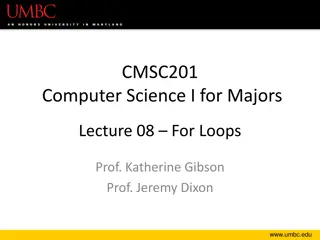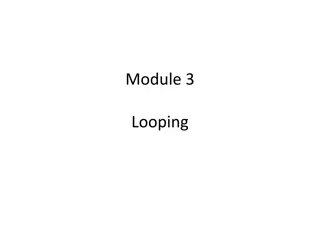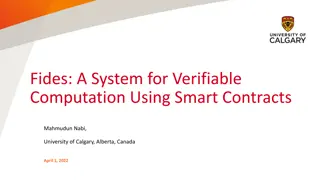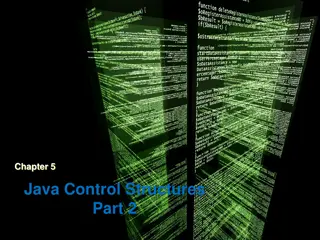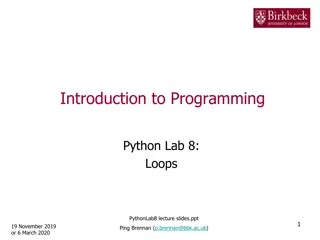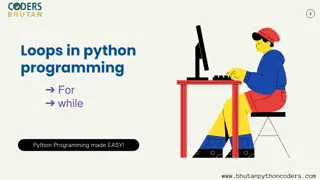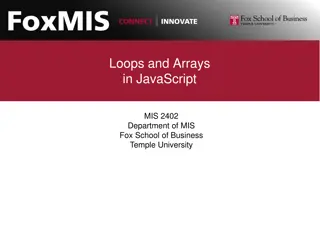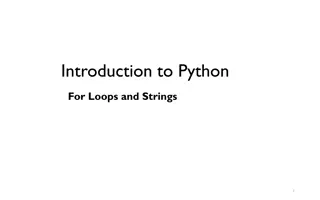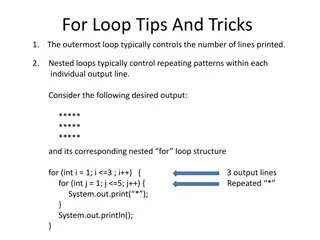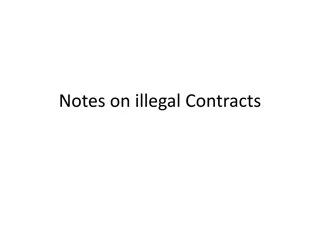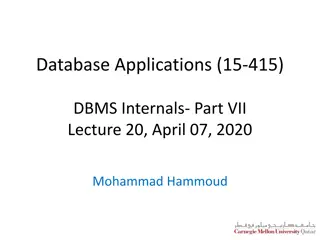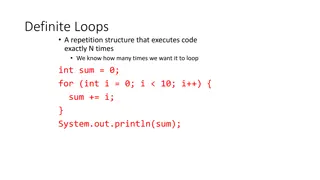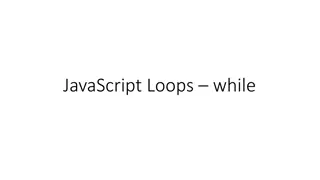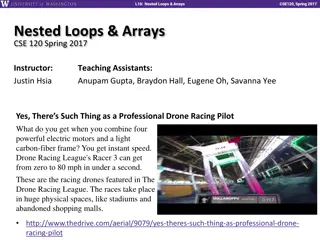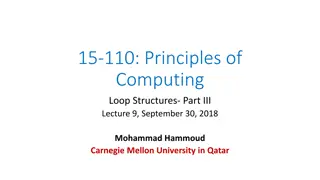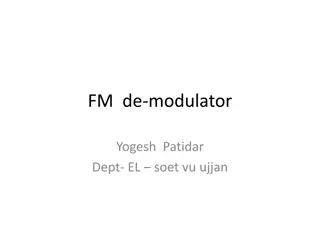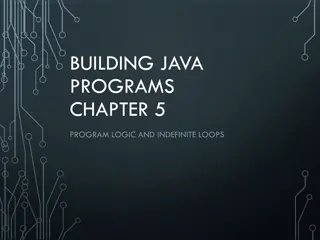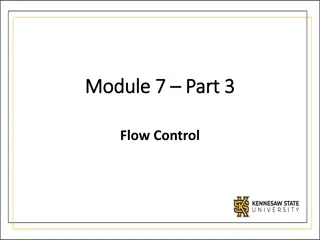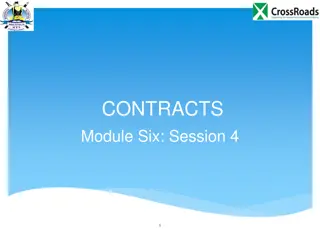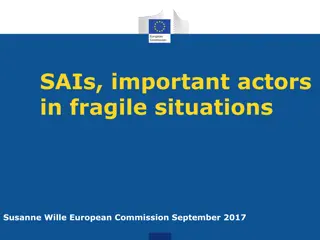Understanding Loops in Smart Contracts: A Deep Dive Analysis
Smart contracts play a crucial role in various applications, and understanding loop structures within them is essential for security and expected behavior. This study demystifies the prevalence, patterns, and syntactic analysis of loops in smart contracts, shedding light on their significance and impact on security.
Download Presentation

Please find below an Image/Link to download the presentation.
The content on the website is provided AS IS for your information and personal use only. It may not be sold, licensed, or shared on other websites without obtaining consent from the author. Download presentation by click this link. If you encounter any issues during the download, it is possible that the publisher has removed the file from their server.
E N D
Presentation Transcript
Demystifying loops in smart contracts Demystifying loops in smart contracts Benjamin Mariano, Benjamin Mariano, Yanju YanjuChen, Chen, Yu Feng, Yu Feng, Shuvendu Shuvendu K. K. Lahiri, Lahiri, and Isil and Isil Dillig Dillig Presented by Yosef Zumer and Yossi Weizman
Agenda Agenda Intro Loops analysis in Solidity Loops main patterns Summarizing solidity loops in CONSUL, evaluation and results Wrap-up
Intro Intro Smart contracts are a hot topic. Security plays a crucial role in smart contracts. Therefore, it s important to analyze the contracts to ensure an expected behavior.
Intro Intro Solidity is the main language for developing smart contracts. A common assumption: Loops aren t common in Solidity. The researcher have found this is inaccurate. The paper aims to understand the behavior of loops in smart contracts, to enhance security of contracts.
Zoom Zoom- -out out The researchers collected smart contracts. Many contracts with loops were found. The researchers analyzed the loops to find common patterns. A DSL (domain-specific language), CONSUL, was developed that fits most patterns. The tool SOLIS was developed, which translates Solidity loops to CONSUL.
Loops prevalence is smart contracts Loops prevalence is smart contracts Over 20K smart contracts were analyzed, using Slither. 20% of the contracts contain loops. 50% of contracts with >200 lines of code contain loops.
Loops Loops prevalence is prevalence is smart contracts smart contracts
Syntactic analysis of loops Syntactic analysis of loops Loops are usually small, ~2 lines of code in average. Nested loops are very rare (<5% of all loops). Loops have 5 variables in average. The length of the loop doesn t significantly affect those proprieties.
Syntactic Syntactic analysis of loops analysis of loops
Syntactic analysis of loops Syntactic analysis of loops 88% of loops contains collections. 75% of loops have a side-affect on contract state (i.e. involve writes). 33% of loops have control-flow (e.g. if statements). 80% of loops don t have a constant bound. 13% of loops contains require statement.
Syntactic Syntactic analysis of loops analysis of loops
Semantic analysis of loops Semantic analysis of loops There are four types of data dependencies in loops. For example: Aggregate array values is covered by the first row in the table. 4 properties aren t specific enough to find patterns in loops
Semantic analysis of loops Semantic analysis of loops To better characterize loops, k-means with 6 clusters was used. For clustering, only 1-sized loops were used. Loops were converted to dependency graph with 37 features. From each cluster, 10 samples were manually investigated. 4 main patterns were found.
Semantic analysis of loops Semantic analysis of loops K K- -means means Each loop was converted to a dependency graph of type: (?,??,??). ? = ?? ?? ?? ??= variables of array indices ??= variables that are written to ??= variables that are read from ??= Edges from ??to ?? ??= Edges from ??to ??
Semantic analysis of loops Semantic analysis of loops K K- -means means Each loop was converted to a dependency graph of type: (?,??,??). ? = ?? ?? ?? ??= variables of array indices ??= variables that are written to ??= variables that are read from ??= Edges from ??to ?? ??= Edges from ??to ??
Semantic analysis of loops Semantic analysis of loops K K- -means means Each loop was converted to a dependency graph of type: (?,??,??). ? = ?? ?? ?? ??= variables of array indices ??= variables that are written to ??= variables that are read from ??= Edges from ??to ?? ??= Edges from ??to ?? Each loop is represented by 37 features. For example: Maximum length from ??to ??
Semantic analysis of loops Semantic analysis of loops Patterns Patterns After manually examine each of k-mean s clusters, 4 main patterns were found: 1. Fold Perform an accumulation over a collection 2. Map - Apply a function to elements of a collection 3. Require Enforce a predicate over a collection 4. Zip Pairwise aggregate collection
Semantic analysis of loops Semantic analysis of loops Patterns Patterns After manually examine each of k-mean s clusters, 4 main patterns were found: 1. Fold Perform an accumulation over a collection 2. Map - Apply a function to elements of a collection 3. Require Enforce a predicate over a collection 4. Zip Pairwise aggregate collection
Semantic analysis of loops Semantic analysis of loops Patterns Patterns After manually examine each of k-mean s clusters, 4 main patterns were found: 1. Fold Perform an accumulation over a collection 2. Map - Apply a function to elements of a collection 3. Require Enforce a predicate over a collection 4. Zip Pairwise aggregate collection
Semantic analysis of loops Semantic analysis of loops Patterns Patterns After manually examine each of k-mean s clusters, 4 main patterns were found: 1. Fold Perform an accumulation over a collection 2. Map - Apply a function to elements of a collection 3. Require Enforce a predicate over a collection 4. Zip Pairwise aggregate collection
Semantic analysis of loops Semantic analysis of loops Patterns Patterns After manually examine each of k-mean s clusters, 4 main patterns were found: 1. Fold Perform an accumulation over a collection 2. Map - Apply a function to elements of a collection 3. Require Enforce a predicate over a collection 4. Zip Pairwise aggregate collection * Additionally, an arithmetic pattern was found. But it s rare
CONSUL DSL CONSUL DSL
CONSUL DSL CONSUL DSL Transfer of amount ?2 [?] from the receiver object to address ?1 [?] for all keys ? satisfying predicate
CONSUL DSL CONSUL DSL
CONSUL CONSUL - - Nested Nested Nested behavior is a common pattern in loops. It uses values of one map as indexes of another map:
CONSUL DSL CONSUL DSL - - Examples Examples
SOLIS SOLIS SOLIS is a tool for automatically synthesizing loop summaries. It converts Solidity loops into CONSUL summaries. For each loop, SOLIS searches candidate patterns for conversion. It performs pruning based on pre-conditions. Executes the converted code and the original code (bounded). Compares the output state.
SOLIS SOLIS
SOLIS SOLIS equivalency check equivalency check Lastly, SOLIS check the equivalency of a candidate summary (in CONSUL) to the original loop. SOLIS converts the CONSUL summary back to Solidity. SOLIS runs both the original loop and the new one k times (both start with the same initial state). SOLIS compares the state of the original code and the new translated code. If both states equivalent, then the CONSUL summary is correct.
SOLIS SOLIS equivalency check equivalency check
SOLIS SOLIS Compositional Synthesis Compositional Synthesis The search space of candidates is exponentially in the number of statements. Therefore, instead of converting the whole loop, we ll have partial summaries, and then sequence them. The summary is for each variable which is written in the loop. Compose together
SOLIS SOLIS Compositional Synthesis Compositional Synthesis Advantages Saves runtime Keeps the soundness of the algorithm Disadvantages Incomplete: For P = S1;S2 If S2 depends on S1 (variables read in S2 are written in S1) partial summary isn t possible
SOLIS SOLIS Which loops cannot be summarized? Which loops cannot be summarized? Group 1: The semantics of the loop aren t supported by CONSUL For example: nested loops Group 2: Summary fails due to the incomplete decomposition heuristics employed by SOLIS
SOLIS SOLIS Which loops cannot be summarized? Which loops cannot be summarized?
Results Results 56% of loops can be expressed by CONSUL summary. 81% of these summaries are equivalent to the original loop. The most common summary of a loop is to map operator
Wrap Wrap- -up up What did we see? Analyzing patterns in loop using static analysis and k-means clustering. CONSUL a DSL for loops summary in smart contracts. SOLIS a tool for creating CONSUL summaries from Solidity code. Key take-aways Loops are common in Solidity and should be considered when analyzing smart contracts. Tools like SOLIS can give better visibility to smart contracts, thus improving security.


